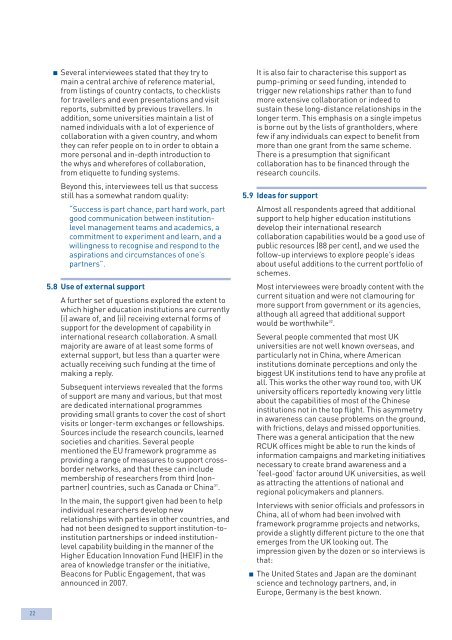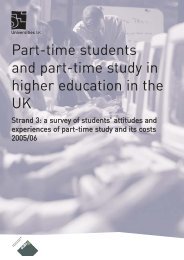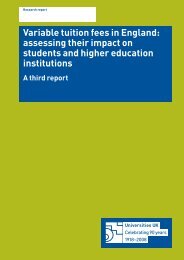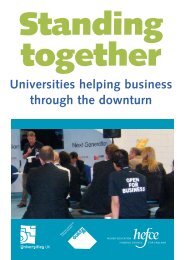International Research Collaboration - GlobalHigherEd
International Research Collaboration - GlobalHigherEd
International Research Collaboration - GlobalHigherEd
You also want an ePaper? Increase the reach of your titles
YUMPU automatically turns print PDFs into web optimized ePapers that Google loves.
p Several interviewees stated that they try tomain a central archive of reference material,from listings of country contacts, to checklistsfor travellers and even presentations and visitreports, submitted by previous travellers. Inaddition, some universities maintain a list ofnamed individuals with a lot of experience ofcollaboration with a given country, and whomthey can refer people on to in order to obtain amore personal and in-depth introduction tothe whys and wherefores of collaboration,from etiquette to funding systems.Beyond this, interviewees tell us that successstill has a somewhat random quality:“Success is part chance, part hard work, partgood communication between institutionlevelmanagement teams and academics, acommitment to experiment and learn, and awillingness to recognise and respond to theaspirations and circumstances of one’spartners”.5.8 Use of external supportA further set of questions explored the extent towhich higher education institutions are currently(i) aware of, and (ii) receiving external forms ofsupport for the development of capability ininternational research collaboration. A smallmajority are aware of at least some forms ofexternal support, but less than a quarter wereactually receiving such funding at the time ofmaking a reply.Subsequent interviews revealed that the formsof support are many and various, but that mostare dedicated international programmesproviding small grants to cover the cost of shortvisits or longer-term exchanges or fellowships.Sources include the research councils, learnedsocieties and charities. Several peoplementioned the EU framework programme asproviding a range of measures to support crossbordernetworks, and that these can includemembership of researchers from third (nonpartner)countries, such as Canada or China 31 .In the main, the support given had been to helpindividual researchers develop newrelationships with parties in other countries, andhad not been designed to support institution-toinstitutionpartnerships or indeed institutionlevelcapability building in the manner of theHigher Education Innovation Fund (HEIF) in thearea of knowledge transfer or the initiative,Beacons for Public Engagement, that wasannounced in 2007.It is also fair to characterise this support aspump-priming or seed funding, intended totrigger new relationships rather than to fundmore extensive collaboration or indeed tosustain these long-distance relationships in thelonger term. This emphasis on a single impetusis borne out by the lists of grantholders, wherefew if any individuals can expect to benefit frommore than one grant from the same scheme.There is a presumption that significantcollaboration has to be financed through theresearch councils.5.9 Ideas for supportAlmost all respondents agreed that additionalsupport to help higher education institutionsdevelop their international researchcollaboration capabilities would be a good use ofpublic resources (88 per cent), and we used thefollow-up interviews to explore people’s ideasabout useful additions to the current portfolio ofschemes.Most interviewees were broadly content with thecurrent situation and were not clamouring formore support from government or its agencies,although all agreed that additional supportwould be worthwhile 32 .Several people commented that most UKuniversities are not well known overseas, andparticularly not in China, where Americaninstitutions dominate perceptions and only thebiggest UK institutions tend to have any profile atall. This works the other way round too, with UKuniversity officers reportedly knowing very littleabout the capabilities of most of the Chineseinstitutions not in the top flight. This asymmetryin awareness can cause problems on the ground,with frictions, delays and missed opportunities.There was a general anticipation that the newRCUK offices might be able to run the kinds ofinformation campaigns and marketing initiativesnecessary to create brand awareness and a‘feel-good’ factor around UK universities, as wellas attracting the attentions of national andregional policymakers and planners.Interviews with senior officials and professors inChina, all of whom had been involved withframework programme projects and networks,provide a slightly different picture to the one thatemerges from the UK looking out. Theimpression given by the dozen or so interviews isthat:p The United States and Japan are the dominantscience and technology partners, and, inEurope, Germany is the best known.22
















